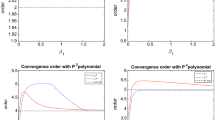Abstract
Discontinuous Galerkin finite element spatial discretizations are often used in a method-of-lines approach with an ordinary differential equation solver to step the solution forward in time. Explicit strong-stability-preserving time steppers are a popular choice because they provably preserve the nonlinear stability properties of the forward Euler method applied to discontinuous Galerkin semi-discretized equations, subject to a time step constraint. While nonlinear stability is guaranteed by strong-stability-preservation, a separate condition for linear stability of the combined scheme must also be satisfied. In this work, we assess the linear stability properties of discontinuous Galerkin spatial discretizations with a set of strong-stability-preserving multistep Runge–Kutta methods. We find that, in all cases, the constraint for linear stability is more strict than that for strong-stability-preservation. For each order, from the set of multistep Runge–Kutta methods, we select an optimal time stepper that requires the fewest evaluations of the discontinuous Galerkin operator. All methods are tested for convergence in application to both a linear and a nonlinear partial differential equation, and all methods are found to converge in both cases using the maximum stable time step as determined by the stability constraints found in this paper.




Similar content being viewed by others
Data availability
All data generated are included in the publication.
References
Aizinger, V., Dawson, C., Cockburn, B., Castillo, P.: The local discontinuous Galerkin method for contaminant transport. Adv. Water Resour. 24, 73–87 (2001)
Benedir, M.: On the root distribution of general polynomials with respect to the unit circle. Signal Process. 53, 75–82 (1995)
Biswas, R., Devine, K.D., Flaherty, J.: Parallel, adaptive finite element methods for conservation laws. Appl. Numer. Math. 14, 255–283 (1994)
Bresten, C., Gottlieb, S., Grant, Z., Higgs, D., Ketcheson, D., Németh, A.: Explicit strong stability preserving multistep Runge–Kutta methods. Math. Comput. 86(304), 747–769 (2017)
Butcher, J.C.: Numerical Methods for Ordinary Differential Equations, 2nd edn. Wiley, Hoboken (2008)
Chapelier, J.B., de la Llave Plata, M., Renac, F., Lamballais, E.: Evaluation of a high-order discontinuous Galerkin method for the DNS of turbulent flows. Comput. Fluids 95, 210–226 (2014)
Cheng, Y., Li, F., Qiu, J., Xu, L.: Positivity-preserving DG and central DG methods for ideal MHD equations. J. Comput. Phys. 238, 255–280 (2013)
Cockburn, B., Hou, S., Shu, C.W.: The Runge–Kutta local projection discontinuous Galerkin finite element method for conservation laws IV: the multidimensional case. Math. Comput. 54(190), 545–581 (1990)
Cockburn, B., Hou, S., Shu, C.W.: The Runge–Kutta discontinuous Galerkin method for conservation laws V: multidimensional systems. J. Comput. Phys. 141, 199–224 (1998)
Cockburn, B., Lin, S.Y., Shu, C.W.: TVB Runge–Kutta local projection discontinuous Galerkin finite element method for conservation laws III: one-dimensional systems. J. Comput. Phys. 84, 90–113 (1989)
Cockburn, B., Shu, C.W.: The Runge–Kutta local projection \({P}^1\)-discontinuous Galerkin finite element method for scalar conservation laws. Math. Modell. Numer. Anal. 25(3), 337–361 (1989)
Cockburn, B., Shu, C.W.: TVB Runge–Kutta local projection discontinuous Galerkin finite element method for scalar conservation laws II: general framework. Math. Comput. 52, 411–435 (1989)
Cockburn, B., Shu, C.W.: Runge–Kutta discontinuous Galerkin methods for convection-dominated problems. J. Sci. Comput. 16(3), 173–261 (2001)
Eskilsson, C., Sherwin, S.J.: A triangular spectral \(hp\) discontinuous Galerkin method for modelling 2d shallow water equations. Eng. Comput. 45, 605–623 (2004)
Gottlieb, S., Ketcheson, D., Shu, C.W.: Strong Stability Preserving Runge–Kutta and Multistep Time Discretizations. World Scientific, Singapore (2011)
Krivodonova, L., Qin, R.: An analysis of the spectrum of the discontinuous Galerkin method. Appl. Numer. Math. 64, 1–18 (2013)
Kubatko, E.J., Bunya, S., Dawson, C., Westerink, J.J.: Dynamic p-adaptive Runge–Kutta discontinuous Galerkin methods for the shallow water equations. Comput. Methods Appl. Mech. Eng. 198, 1766–1774 (2009)
Kubatko, E.J., Westerink, J.J., Dawson, C.: \(hp\) discontinuous Galerkin methods for advection dominated problems in shallow water flow. Comput. Methods Appl. Mech. Eng. 196, 437–451 (2006)
Kubatko, E.J., Westerink, J.J., Dawson, C.: Semidiscrete discontinuous Galerkin methods and stage exceeding order strong stability preserving Runge–Kutta time discretizations. J. Comput. Phys. 222, 832–848 (2007)
Kubatko, E.J., Yeager, B.A.: Optimal strong-stability-preserving Runge–Kutta time discretizations for discontinuous Galerkin methods. J. Sci. Comput. 60, 313–344 (2014)
Mirabito, C., Dawson, C., Kubatko, E.J., Westerink, J.J., Bunya, S.: Implementation of a discontinuous Galerkin morphological model on two-dimensional unstructured meshes. Comput. Methods Appl. Mech. Eng. 200, 189–207 (2011)
Puelza, C., Čanić, S., Rivière, B., Rusin, C.G.: Comparison of reduced models for blood flow using Runge–Kutta discontinuous Galerkin methods. Appl. Numer. Math. 115, 114–141 (2017)
Schur, J.: Über potenzreihen, die im innern des einheitskreises beschränkt sind. Journal für die reine und angewandte Mathematik 1917(147), 205–232 (1917)
Shu, C.W., Osher, S.: Efficient implementation of essentially non-oscillatory shock-capturing schemes. J. Comput. Phys. 77, 439–471 (1988)
Sun, T., Qiu, J.: LWDG method for a multi-class traffic flow model on an inhomogeneous highway. Adv. Appl. Math. Mech. 1(3), 438–450 (2009)
Trahan, C.J., Dawson, C.: Local time-stepping in Runge–Kutta discontinuous Galerkin finite element methods applied to the shallow-water equations. Comput. Methods Appl. Mech. Eng. 217, 139–152 (2012)
Xing, Y., Shu, C.W.: High order well-balanced finite volume WENO schemes and discontinuous Galerkin methods for a class of hyperbolic systems with source terms. J. Comput. Phys. 214, 567–598 (2010)
Xing, Y., Zhang, X., Shu, C.W.: Positivity-preserving high order well-balanced discontinuous Galerkin methods for the shallow water equations. Adv. Water Resour. 33, 1476–1493 (2010)
Funding
The authors would like to acknowledge funding from NSF Grants EAR-1520870 and ICER-1855047.
Author information
Authors and Affiliations
Corresponding author
Ethics declarations
Conflict of interest
The authors declare no conflicts of interest with the material presented in this paper.
Additional information
Publisher's Note
Springer Nature remains neutral with regard to jurisdictional claims in published maps and institutional affiliations.
A Time Step Restrictions for SSP MSRK Methods with DG Spatial Discretizations
A Time Step Restrictions for SSP MSRK Methods with DG Spatial Discretizations
See Tables 2, 3, 4, 5, 6, 7, 8, 9 and 10.
Rights and permissions
About this article
Cite this article
Yeager, B., Kubatko, E. & Wood, D. Time Step Restrictions for Strong-Stability-Preserving Multistep Runge–Kutta Discontinuous Galerkin Methods. J Sci Comput 89, 29 (2021). https://doi.org/10.1007/s10915-021-01635-4
Received:
Revised:
Accepted:
Published:
DOI: https://doi.org/10.1007/s10915-021-01635-4




